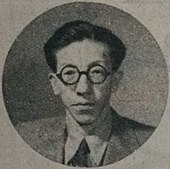Sugiyama Yasushi
Sugiyama Yasushi ( Japanese 杉山 寧 ; born October 20, 1909 in Tokyo ; died October 20, 1993 in Tokyo) was a Japanese painter of the Nihonga direction during the Shōwa period .
life and work
Sugiyama Yasushi won a prize at the 11th Teiten exhibition while he was still in training at the Tokyo Art Academy ( 東京 美術 学校 , Tōkyō bijutsu gakkō ). For this he was honored as a specially selected student the following year. After completing his education in 1933 he became a student of Matsuoka Eikyū ( 松岡 映 丘 ; 1881-1938) and founded, together with other students, such as Yamamoto Kyūjin and Urata Masao, the artists' association Rusō Gasha ( 瑠 爽 画 社 ), the three Held exhibitions before disbanding.
After a hiatus for health reasons, Sugiyama resumed painting in 1943. When the Pacific War ended, he and Higashiyama Kaii exhibited their paintings at the Nitten exhibitions with such success that these years are known as the "Higashiyama Sugiyama Period". In 1957 Sugiyama won the Japanese Academy of Art and in 1960 worked on the design of the Togu Palace for the Crown Prince. In 1970 he became a member of the Art Academy, in 1974 he received the Order of Culture .
Sugiyama did not try to depict things realistically, he rather summarized them, using lighting as a design element with a sure feeling. This is how mental landscapes and almost abstract spaces were created. His representative works include “Vaults” ( 穹 Kyū ; 1964) in the National Museum of Modern Art Tokyo , which depicts the Great Sphinx of Giza at night , and “Resonance” ( 響 ).
literature
- S. Noma (Ed.): Sugiyama Yasushi . In: Japan. An Illustrated Encyclopedia. Kodansha, 1993. ISBN 4-06-205938-X , p. 1467.
- Tazawa, Yutaka: Sugiyama Yasushi . In: Biographical Dictionary of Japanese Art. Kodansha International, 1981. ISBN 0-87011-488-3 .
Web links (images)
Individual proof
- ↑ a b Teiten ( 帝 展 ) is the abbreviation for the annual state art exhibition ( 帝国 美術展 覧 会 , Teikoku bijutsu-in tenrankai ) between 1919 and 1935. The successor institution from 1946 is called Nitten ( 日 展 ) for Nihon bijutsu tenrankai ( 日本美術展 覧 会 ).
| personal data | |
|---|---|
| SURNAME | Sugiyama, Yasushi |
| ALTERNATIVE NAMES | 杉山 寧 (Japanese) |
| BRIEF DESCRIPTION | Japanese painter |
| DATE OF BIRTH | October 20, 1909 |
| PLACE OF BIRTH | Tokyo |
| DATE OF DEATH | October 20, 1993 |
| Place of death | Tokyo |
